#solar panel angle bracket
Explore tagged Tumblr posts
Video
youtube
☀️ FIXDEX solar fixing and all kinds of photovoltaic barcket
#youtube#FIXDEX solar fixing#solar bracketphotovoltaic bracket#solar panel bracket installation#pv bracket#solar angle brackets#solar panel and bracket#solar panel brackets#solar mounting brackets#solar brackets for tile roof#solar pv brackets#solar pv mounting brackets#olar panel rails and brackets#pv panel mounting brackets#pv panel brackets#pv roof brackets#pv support bracket#solar panel angle bracket#FIXDEX sloar fixing
1 note
·
View note
Text
Trust or Try? Deciding Who Should Handle Your Solar Panel Installation
Maybe you’ve been thinking about adding solar to your home. There’s a lot of talk about energy bills rising, plus everyone seems to know someone who’s installed solar panels lately. But can you, or should you, take on the Solar Panel Installation yourself? Or does it make more sense to let the experts take over?
It’s an interesting situation. Some people are keen DIYers, love a project, and want to get their hands on the tech. Others prefer to sit back, let skilled professionals do their thing, and enjoy peace of mind.
What's Involved? More Than Meets the Eye
Installing Solar Power Systems in Sydney isn’t like putting together a furniture flat pack. Sure, it’s tempting to think, “Panels, brackets, wires, how hard can it be?” But the process hides a surprising number of steps. Roof angle. System sizing. Finding a safe spot for the inverter. Wiring that actually works, won’t fail, and follows the rules. Not to mention choosing the right system for Sydney’s weather.
Should you risk it? Some eager homeowners jump in, thinking they can save a bit of cash. Sometimes, the result is not what they pictured.
The DIY Approach: What’s at Stake?
So, what does a typical do-it-yourselfer face? Here’s where things often go sideways:
Safety risks: Electricity isn’t something you want to gamble with. One wrong move and someone could get hurt.
Insurance issues: Many home policies won’t cover problems from unapproved Solar Panel Installation.
No warranty: Try to file a warranty claim after a mistake and you may find yourself on your own.
Many suppliers and manufacturers only stand by products installed by accredited experts. It’s a hard truth.

Why Do People Trust the Pros?
Most seasoned homeowners or business owners in Sydney will recommend leaving Solar Power Systems in Sydney to those who handle them every day. Experienced teams know the local council rules. They know the climate. They know how to design and fit solar systems that last.
The benefits speak for themselves:
Certified quality: Proper systems follow strict standards, supporting long system life.
Stress-free: You don’t need to worry about the details. The experts sort out approval, connection, and paperwork.
Saves you time: The installer handles the technical stuff. You keep your weekends free.
Why Use CEC-Accredited Professionals?
You want the job done right, no cutting corners. CEC-accredited installers have the training needed to get it right. They use quality parts and methods suited to Sydney roofs and sun. Cutting corners now can cost more later.
Mistakes add up: Leaks, electrical fires, panel malfunctions. These often happen with rushed or unqualified installs. Professionals spot risks most DIYers miss.
DIY or Pro? The Final Word
Could you do it yourself? Maybe. Should you? Weigh the risks and rewards carefully.
Ask yourself: Is saving a few dollars now worth risking a system that doesn’t perform, or worse, is unsafe? For most, peace of mind matters more.
Want a solar setup that works, keeps you safe, and saves you money? Let the Sydney experts handle your Solar Panel Installation. Project Solar Group makes going solar simple, safe, and affordable. Reach out for a free, friendly chat about Solar Power Systems in Sydney and see what qualified professionals can do for your home or business.
0 notes
Text
Solar Roof Mounting Systems: A Comprehensive Guide to Technology and Applications
Introduction: The Core of Rooftop Solar Solutions Solar roof mounting systems are structural frameworks that secure photovoltaic (PV) modules to building rooftops, enabling efficient conversion of solar energy to electricity. These systems are pivotal in distributed energy generation, addressing key needs: spatial optimization, energy efficiency, and architectural compatibility. For instance, a well-designed system in the Northern Hemisphere typically tilts modules at 30°–45° to maximize sunlight absorption, while integrating with roof materials to ensure waterproofing and load-bearing capacity.
Key Components and Technical Architecture 1. Support Structures – Mounting Brackets: Predominantly made of aluminum alloy or galvanized steel, these brackets withstand wind loads exceeding 120 km/h and resist corrosion. Two main types exist: – Fixed Mounts: Cost-effective, ideal for roofs with fixed optimal angles. – Tracking Mounts: Motorized systems that adjust module angles throughout the day, boosting power output by 15%–25%. – Connectors: Bolts, clamps, and adapters certified under ISO 9001 ensure secure module attachment to roofs.
2. PV Module Integration – Monocrystalline or polycrystalline panels (18%–22% efficiency) are paired with junction boxes and cables for electrical connectivity.
3. Auxiliary Systems – Lightning Protection: Grounding networks and surge protectors mitigate risks. – Drainage Mechanisms: Integrated channels prevent water accumulation on roofs.
Installation Workflow and Standards 1. Pre-Installation Assessment – Roof load testing (minimum 15 kg/m²) and solar irradiance analysis (4+ hours/day optimal). 2. Design & Simulation – Using tools like PVsyst to model energy yield and layout efficiency. 3. Construction – Bracket alignment → module fixation → electrical wiring → grounding, compliant with UL 2703 and TÜV standards. 4. Quality Assurance – Insulation tests, power output verification, and compliance with ISO 13485 for safety.
Selection and Maintenance Tips – Material Compatibility: Choose brackets based on roof type (e.g., clip-on mounts for metal roofs, penetrative systems for concrete). – Maintenance Protocol: Quarterly cleaning of module surfaces and annual checks for bracket corrosion or loose fasteners extend system life to 25+ years.
Conclusion Solar roof mounting systems have evolved from niche solutions to essential components of sustainable architecture. As technologies like thin-film PV integration advance, their role in decarbonizing urban energy grids will only grow. For stakeholders, prioritizing certified systems (e.g., ISO 14001) and local service providers ensures long-term performance and ROI, solidifying their status as a cornerstone of the global renewable energy transition.
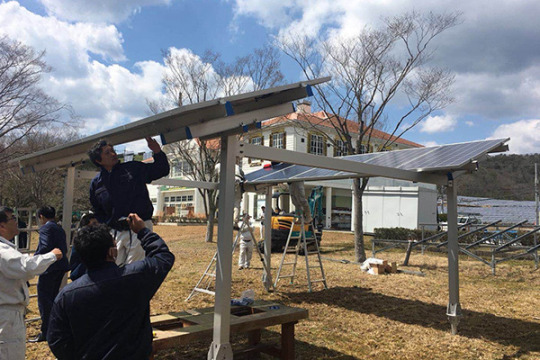
0 notes
Text
Is Your Flat Roof Ready for Solar Pool Panels? Here’s What to Know
If your home or pool house has a flat or low-slope roof, you might be wondering if it limits your options for solar pool heating installs. The short answer is no—flat roofs are perfectly compatible with pool solar panels installation, as long as the system is designed with the right components and angles.
In fact, flat roofs can offer some advantages for solar heating setups, especially when paired with modular, cold-climate panels like the Thermax solar pool panels from Northern Lights Solar Solutions.

Why Flat Roofs Work for Solar Pool Panels
Flat roofs give you flexibility. Unlike pitched roofs, which lock you into a fixed orientation and angle, flat roofs allow you to set your panels at the ideal tilt for your climate and sun exposure. In northern regions, for example, a steeper tilt (30°–45°) helps maximize solar gain in spring and fall when the sun sits lower in the sky.
Thermax panels are designed for this type of adaptability. They’re modular and can be mounted on angled brackets to optimize performance. Whether you want a landscape layout or vertical stack, the system can be arranged to match the roof layout and maximize output.
Installation Considerations for Flat Roofs
Installing solar pool panels on a flat roof involves a few important planning steps:
Proper tilt angle: Panels should face true south (in the northern hemisphere) and be mounted at an angle that matches your latitude for best efficiency.
Sturdy brackets: Racking systems or angled frames are required to support the panels securely and direct rainwater runoff. Avoid laying them flat against the roof.
Drainage and airflow: Adequate spacing allows for ventilation and prevents debris from collecting underneath.
Accessibility: Flat roofs make maintenance easier—something to keep in mind if you're running a year-round system.
The Thermax system includes high-performance HDPE panels that are UV-resistant and durable in extreme temperatures. Their compact size and 85% solar efficiency mean fewer panels are needed, freeing up roof space and making layout planning easier.
Cold-Climate Advantage
Many solar mat systems struggle in early spring or late fall. Thermax panels are built for northern climates and can heat efficiently even when temperatures drop. They’re tested to perform at low sun angles—perfect for maximizing output on flat roofs during the shoulder seasons.
Pairing the panels with a Pentair SolarTouch controller and motorized valve ensures automatic, reliable flow control and temperature regulation, even on variable weather days.
Closing Statement
Flat roofs aren’t a limitation—they’re an opportunity. With the right system and professional guidance, your roof can become a powerful source of sustainable pool heating.
Northern Lights Solar Solutions offers full pool solar panels installation packages featuring Thermax HDPE panels, expert support, and all the hardware you need for a clean, efficient setup on flat or sloped surfaces.
#solar pool heating#solar pool heater#solar installation#pool heating system#solar energy#solar heater for pool#solar power#solar swimming pool heating system
0 notes
Text
Selecting The Right Solar Panel Roof Rack Mounting Kit?
With the increasing shift toward sustainable energy, solar power is quickly becoming a preferred choice for homeowners and businesses. While selecting high-quality solar panels is essential, one element that often goes unnoticed is the mounting system.
Choosing the right solar panel roof rack mounting kit is vital to ensuring the long-term safety, performance, and durability of your solar installation. In this blog, we will examine the key factors to consider when selecting the most suitable mounting kit for your solar energy system.
Understanding the Role of Mounting Kits
The mounting kit is more than just a support structure. It serves as the foundation that securely holds your panels in place, ensuring they withstand harsh weather conditions while maintaining the optimal tilt and orientation for energy production.
A reliable mounting system also protects your roof from leaks and structural damage, making it a critical component of the overall solar setup.

Evaluate the Roof Type Before Selecting a Kit
Roofs vary in design and material, which directly impacts the type of mounting kit required. Here are common roof types and suitable mounting options:
Pitched Roofs: These roofs generally require rail-based mounting systems that allow for adjustable tilt angles, maximising sun exposure.
Flat Roofs: Ballasted systems or tilt mounting frames are commonly used to achieve the correct angle without penetrating the roof surface.
Metal Roofs: Specialised clamps can be used that do not require drilling, preserving the integrity of the roofing material.
Understanding your roof type will help you select a mounting system that ensures both performance and longevity.
Key Components of a Quality Mounting Kit
A dependable solar panel roof rack mounting kit should include components designed for strength and weather resistance. Common elements include:
Aluminium rails for lightweight durability
Stainless steel bolts and fasteners
Roof-specific brackets or clamps
Waterproof flashing to prevent leaks
All materials should be corrosion-resistant to withstand long-term exposure to the elements. Opting for kits certified for wind and snow loads in your region is an added advantage.
Consider Tilt and Orientation for Maximum Efficiency
The tilt angle and orientation of the panels heavily influence the performance of a solar energy system. An adjustable solar panel roof rack mounting kit enables you to fine-tune the angle for optimal seasonal sun paths, thereby improving energy yield.
Ideally, panels should face south in the Northern Hemisphere to maximise sun exposure. A well-designed mounting system enables this kind of customisation and boosts overall system efficiency.
Safety and Compliance Should Be Prioritised
Mounting kits must comply with local building codes and industry safety standards. A subpar kit may not withstand extreme conditions, such as high winds or heavy snow, putting your panels and property at risk.
Look for kits that have been tested for structural reliability and certified by recognised bodies. It is also essential to hire an experienced installer who understands the specific requirements of the mounting system you choose.
Invest in Long-Term Value
While it may be tempting to cut costs by choosing a lower-priced mounting kit, this approach can lead to higher expenses in the long run due to potential damage or system failure.
A well-built mounting kit may cost more upfront, but it ensures greater stability, fewer maintenance issues, and a longer lifespan for your entire solar setup.
Consider warranty coverage, material quality, and future scalability when evaluating your options to ensure optimal performance and long-term value.
Conclusion
Selecting the right solar panel roof rack mounting kit is a crucial step in the solar installation process. It plays a vital role in maintaining the efficiency, safety, and durability of your solar energy system.
By considering your roof type, required tilt angle, material quality, and compliance standards, you can make an informed decision that enhances the long-term performance of your investment.
A reliable mounting kit is not just an accessory; it is the backbone of a successful solar installation. Make the right decision today to ensure your solar panels deliver maximum power for years to come.
0 notes
Photo

Outdoor Garden Solar Flood Light The outdoor garden solar floodlight is an intelligent outdoor lighting device based on photovoltaic power generation. It adopts high-brightness LED light source and light/human body sensing dual-mode control system, supports wide-angle illumination and remote dimming functions, and provides night security lighting and landscape lighting solutions for scenes such as courtyards, gardens, and parking lots. Product advantages: integrated high-efficiency solar panels and 1200LM high-power LEDs to achieve rapid energy storage, ultra-long battery life and high-brightness coverage; IP65 waterproof rating and adjustable bracket design adapt to all-weather complex environments and multi-angle installation requirements, with both intelligent energy saving and high reliability. Minimum order quantity: 500 Delivery time: 15-25 days Factory location: Zhongshan, Guangdong, China https://jinzho.com/wp-content/uploads/2025/05/2-192.jpg
0 notes
Text
How to Install Solar Motion Sensor Lights for Maximum Coverage
Installing solar motion sensor lights is one of the most effective ways to enhance home security while reducing energy usage. These lights are powered by the sun and activate when motion is detected, making them ideal for driveways, walkways, and backyard areas. However, to ensure you get the best performance and widest range of coverage, strategic installation is essential. Here's a step-by-step guide to help you install them properly.

Choose the Right Location
Before installing your lights, take time to observe your property during the day and night. Identify high-traffic zones where visibility drops after dark, such as entrances, garage doors, garden paths, and alleyways. The goal is to install the lights where movement is most likely to occur, while also ensuring the solar panels receive ample sunlight during the day.
In areas with little or no shade, a solar motion sensor light works best. These devices rely on direct sunlight to charge fully, so avoid mounting them near overhanging roofs, trees, or awnings that may block light. Also, consider the angle of the sun throughout the day to make sure the solar panels are consistently exposed.
Determine the Height and Angle
The height at which you mount your solar motion sensor light greatly affects its range and detection accuracy. A general rule is to position the light between 6 to 10 feet above ground level. At this height, the sensor can detect motion across a broader area without being triggered by small animals or wind-blown debris.
Aim the sensor at a downward angle to improve detection range and reduce blind spots. Most lights have adjustable heads, so take the time to test different angles before finalizing the position.
Test Before Mounting
Before drilling holes or permanently securing the light, conduct a dry run. Use temporary adhesive or tape to place the light in your chosen location. Wait until evening, then test the light's responsiveness to motion, coverage area, and brightness. Walk through the detection zone to ensure consistent activation.
If adjustments are needed, reposition the light slightly and repeat the test. This step helps prevent unnecessary holes in your wall or fence and ensures better coverage.
Secure the Light Properly
Once you're satisfied with the placement, use screws or mounting brackets provided with the unit to attach the light securely. Make sure the solar panel is stable and won’t shift due to wind or rain. Tighten all adjustable parts so the light holds its angle over time.
Perform Regular Maintenance
For optimal performance, clean the solar panel every few weeks to remove dust, dirt, or leaves. Obstructions can reduce charging efficiency, especially during cloudy days. Also, check for loose wires, damaged mounts, or flickering lights as part of routine maintenance.
Installing solar motion sensor lights is a straightforward task that significantly enhances safety and visibility around your home. By choosing the right locations, optimizing angles, and conducting pre-installation tests, you’ll achieve maximum coverage and reliability without relying on electricity or complex wiring.
0 notes
Text
How To Connect Solar Panels To Inverters?

For many customers who purchase solar power systems for the first time, the most concerned issue after purchasing a solar inverter is often: "How to correctly and safely connect solar panels to the inverter?" This step not only determines whether the system can operate normally, but also affects the efficiency and service life of the entire project.
As a professional solar inverter source factory, Xindun shares the key knowledge and operation steps of connecting solar panels to inverters through this article, which is suitable for wholesalers, engineers, system integrators, etc. who want to install by themselves or need to understand the system wiring method.
Clarify the connection type of the solar system
Before formal wiring, you first need to clarify the wiring method of the solar panel. There are usually two basic methods:
Series: increase the system voltage and keep the current unchanged
Parallel: increase the system current and keep the voltage unchanged
Which method you choose depends on the inverter specifications, battery system design, cable distance and load requirements you use. For example, Xindun's low voltage 12V/24V system often uses parallel connection, while high voltage MPPT hybrid inverters mostly use series connection.
Description of series wiring method
In series connection, the "positive pole" of the solar panel is connected to the "negative pole" of the next panel, so that the voltage is superimposed in sequence. This method is suitable for scenarios where the input voltage needs to be increased, such as Xindun's high voltage string hybrid inverter (such as 3KW/5KW/8KW 48V models).
Advantages:
1. The system voltage is high, the current is low, the cable loss is reduced, and it is suitable for long distance transmission.
2. It is more suitable for installation on unobstructed roofs or open spaces with sufficient light.
Notes:
1. The number of panels in series cannot exceed the maximum input voltage limit of the inverter;
2. If one panel is blocked, it may affect the output of the entire string. It is recommended to use an MPPT controller or bypass diode.
Description of parallel wiring method
In parallel connection, the positive pole of each solar panel is connected to the positive pole, and the negative pole is connected to the negative pole, so that the current is superimposed and the voltage remains unchanged. This method is suitable for Xindun's low voltage solar inverter (such as 12V/24V system) and distributed small systems.
Advantages:
1. If a certain panel is blocked or fails, it will not affect other components;
2. It is more suitable for installation environments with variable shadows or for novice users.
Notes:
1. Parallel connection increases the system current, so make sure to use appropriate busbars and overcurrent protection;
2. The total current cannot exceed the maximum carrying current of the controller or inverter.
Typical installation steps (applicable to off grid systems with batteries)
The Xindun off grid or hybrid inverter system supports self installation. It is recommended to strictly follow the following steps to ensure safe operation of the system:
1. Install solar panels
Fix the solar panels in a sunny and unobstructed location (such as a south facing roof). Use a special bracket to ensure wind and corrosion protection, and the angle is recommended to be adjusted according to the local latitude.
2. Connect MPPT or PWM solar charge controller
Most of Xindun's all in one machines have built in MPPT solar charge controllers, and no external connection is required. However, if it is an independent controller, it needs to be placed between the solar panel and the battery to ensure stable charging and discharging and prevent overcharging or reverse connection.
3. Connect the battery to the inverter
Connect the positive (+) and negative (–) terminals of the battery to the DC input port of the inverter. Turn off the inverter power before wiring, and use a fuse or circuit breaker of the corresponding specification.
4. Connect the solar panel to the inverter (or solar controller)
After connecting the solar panels in series or parallel, connect their output to the PV input of the inverter (or MPPT solar controller). Note that the connector uses the MC4 standard interface and confirm the polarity is correct.
I hope the connection method provided by Xindun above can help you connect correctly. If you have any questions, please feel free to contact us.
0 notes
Text
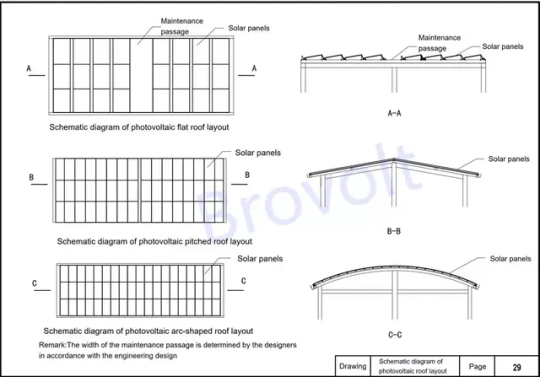
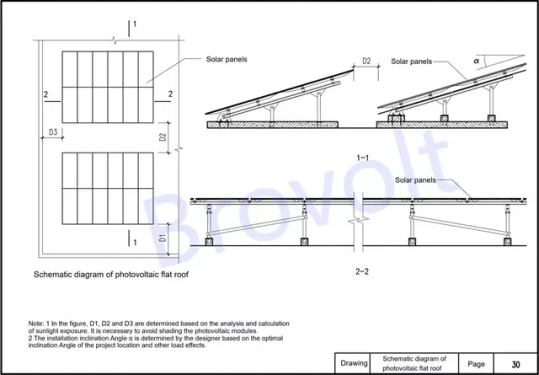
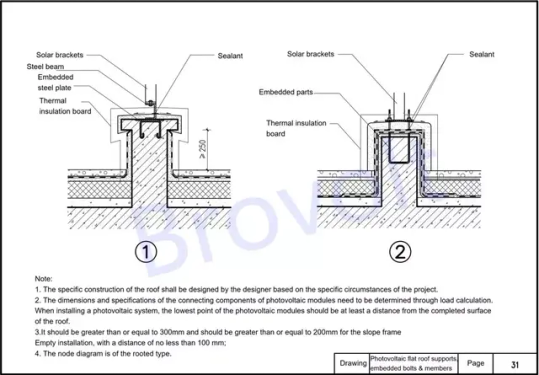
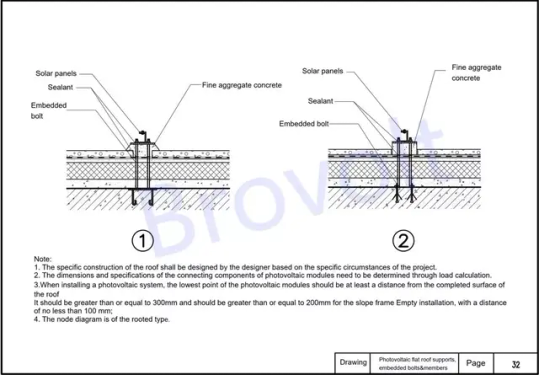
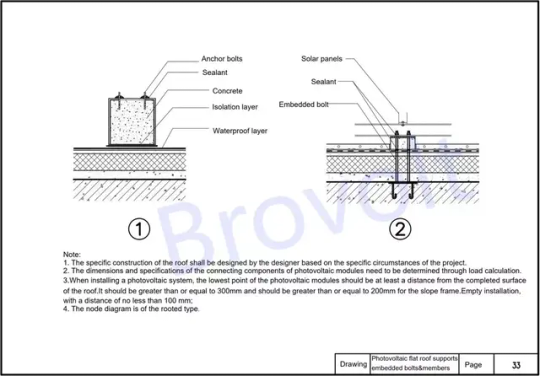
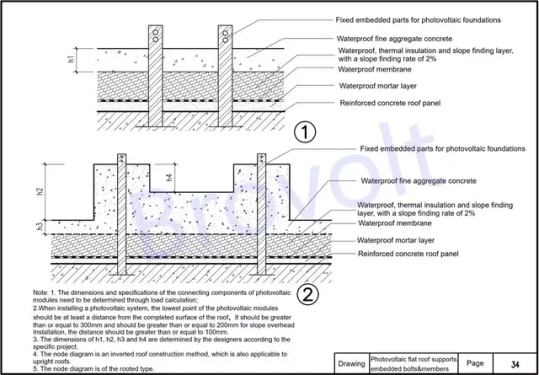
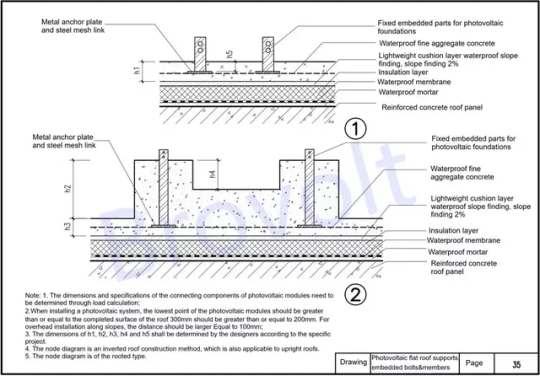
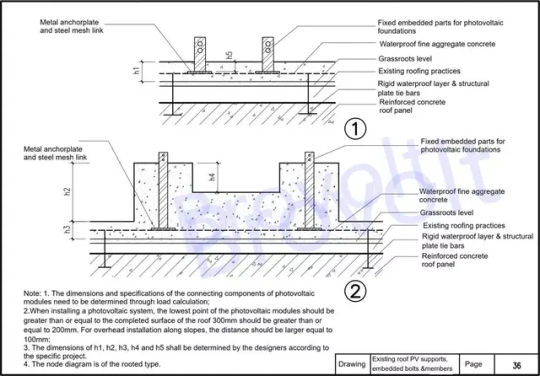
This atlas provides schematic diagrams for solar panel installation, including: PV Roof Layout Shows panel arrangement on sloped or color steel roofs, including spacing and tilt angles. PV Flat Roof Layout Illustrates panel layout on flat concrete roofs, with bracket placement, access paths, and tilt design. Embedded Bolt Installation Details the pre-embedding of foundation bolts for flat roof supports, covering positioning, depth, and waterproofing.
Please check link below to learn more
0 notes
Text
What to Look for in a Solar Sign Lighting Kit

Wattage & Brightness: Ensure the LED output (lumens) matches your sign’s size.
Solar Panel Size: A larger panel captures more sunlight, important for cloudy climates.
Battery Capacity: Look for lithium-ion or lithium iron phosphate batteries for longevity.
Lighting Duration: Choose a system rated for 8–12 hours of nightly operation.
Weather Resistance: Look for IP65 or higher for outdoor durability.
Mounting Flexibility: Adjustable brackets for different angles and placements.
Timer or Photocell Controls: Automatic dusk-to-dawn operation increases convenience.
Installation Tips
Face the Sun: Mount the solar panel to receive maximum sunlight (usually south-facing in the northern hemisphere).
Clear Obstructions: Keep panels free of shade from trees, buildings, or poles.
Sturdy Mounting: Use weatherproof hardware and ensure stable installation for wind resistance.
Regular Maintenance: Clean panels every few months and inspect for debris or wear.
Where to Buy Solar Sign Lighting Kits
When shopping for solar lighting systems for signs, choose from reliable providers that offer:
Complete kits with solar panels, batteries, LEDs, and hardware
Customizable setups for sign size and location
Technical support and installation guides
Durable, commercial-grade components
Shine Bright with Solar
Solar lighting for signs is not only a smart financial move, but it also boosts your visibility, reduces your environmental impact, and eliminates the hassle of wiring and power bills. Whether you’re a small business owner, real estate agent, or property manager, investing in solar sign lighting ensures your message is always visible—without compromise.
#sun in one#solar powered lights#solar power kit off grid#solar powered street light#landscape lighting
1 note
·
View note
Text
Solar Panel Mounting Brackets: A Complete Guide
As the world increasingly turns to renewable energy, solar panels have emerged as a top choice for homeowners and businesses alike. However, what often gets overlooked is the backbone of a solid solar power setup—the solar panel mounting brackets. These brackets ensure your panels stay in place, function efficiently, and withstand harsh weather. In this complete guide, we’ll break down everything you need to know about solar panel mounting brackets, their types, installation tips, and why they matter more than you think.
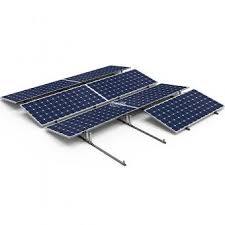
What Are Solar Panel Mounting Brackets?
Solar panel mounting brackets are structural supports that hold solar panels in place on various surfaces—roofs, ground, or poles. They keep your panels at the correct angle to maximize sunlight exposure while ensuring long-term durability. Without proper mounting, even the most expensive solar panels can fail to deliver optimal results.
Types of Solar Panel Mounting Brackets
Choosing the right type of bracket depends on your installation needs. Here are the most common types:
1. Roof-Mounted Brackets
Ideal for residential homes, these brackets attach directly to rooftops. There are two subtypes:
Flush Mounts: Panels lie flat against the roof. Best for locations with high sun exposure.
Tilt Mounts: Allows angling of panels for improved sun capture.
2. Ground-Mounted Brackets
Perfect for open areas where roof space is limited or unsuitable. These are easy to clean and maintain, though they take up land space.
3. Pole-Mounted Brackets
Mounted on poles, these brackets offer flexibility in orientation. They’re especially useful in remote or uneven terrain.
Why Solar Panel Mounting Brackets Matter
Efficiency: Proper brackets keep panels aligned with the sun’s path.
Durability: High-quality mounting systems withstand wind, rain, and snow.
Safety: Secure brackets prevent accidents and reduce maintenance needs.
Scalability: Good systems allow future expansion.
If you’re planning a solar panel installation, never compromise on the mounting hardware. It’s just as critical as the panels themselves.

Key Features to Look For
When choosing mounting brackets, consider the following:
Material Quality: Opt for stainless steel or aluminum for corrosion resistance.
Compatibility: Ensure the brackets match your panel size and type.
Adjustability: Angle adjustments help maximize energy output.
Ease of Installation: Simple designs save time and labor costs.
Wind/Snow Load Ratings: Crucial for regions with extreme weather.
Installation Tips for Better Results
Here are a few best practices to follow:
Use Professional Help: Unless you’re experienced, hire certified installers.
Site Assessment: Ensure your roof or land is structurally sound.
Proper Orientation: In the northern hemisphere, south-facing panels give maximum efficiency.
Spacing: Allow adequate ventilation between panels to avoid overheating.
For a comprehensive selection of durable and easy-to-install mounting brackets,
Cost of Solar Panel Mounting Brackets
While prices vary based on type and quality, brackets usually range between ₹1,500 to ₹10,000 depending on the system’s size and complexity. Investing in good-quality brackets may cost more upfront but saves on maintenance and potential damage in the long run.
Maintenance & Longevity
Solar panel mounting brackets are generally low-maintenance. However, here’s what you should do to extend their lifespan:
Regular Inspection: Check for rust, cracks, or loosened bolts every few months.
Clean Debris: Especially if mounted near trees or dusty areas.
Tighten Fittings: Seasonal changes can cause expansion or loosening.
High-quality brackets can last 25–30 years, which often aligns with the lifespan of the solar panels themselves.
Final Thoughts
Solar panel mounting brackets may not be the most glamorous part of your solar energy system, but they are undoubtedly one of the most essential. Whether you're installing on a rooftop, on the ground, or a remote location, choosing the right brackets ensures your system performs efficiently and safely for decades.
If you're ready to upgrade your solar system with reliable, efficient mounting hardware, don't miss out on our expert-curated options. Learn more at this complete solar panel mounting guide.
0 notes
Text
Install the Solar Collectors
After the mounting brackets are securely in place, it's time to install the solar collectors (panels) on the roof. Properly installing the panels ensures optimal performance and safety. Here's a step-by-step guide for installing the Ariston solar collectors:

1. Prepare the Solar Collectors
Unbox the Collectors: Carefully remove the solar collectors from their packaging. Inspect them for any visible damage. Make sure all components, including the collectors, frame, and any connecting hardware, are accounted for.
Check the Panel Orientation: Before installation, double-check the correct orientation of the panels. The panel's connections should face down (toward the mounting brackets), and the absorber surface should face upward to capture sunlight.
2. Lift the Panels onto the Roof
Ensure Safety: Make sure you have a solid ladder or scaffolding setup to safely lift the panels onto the roof. Have a helper available to assist in lifting and positioning the panels.
Lift with Care: Solar collectors can be bulky, so it’s essential to lift them carefully and avoid bending or damaging the panel. Lift the panels one by one to the roof.
Avoid Scratches and Damage: Be cautious of the roof surface to prevent scratches or dents in the panels. Use protective coverings or padding if necessary.
3. Position the Panels on the Mounting Brackets
Place Panels on the Brackets: Once the panels are lifted onto the roof, position them onto the installed mounting brackets. Carefully align the holes on the panels with the mounting bracket’s fasteners.
Ensure Proper Angle: As you position the panels, make sure that the angle is correct for sunlight exposure (typically between 30-45 degrees) and that the panels are oriented toward the sun’s path.
Align the Panels: If you're installing multiple panels, ensure that each one is aligned with the others and spaced evenly. Use a level to check for even positioning, both horizontally and vertically.
4. Secure the Panels to the Brackets
Attach the Panels: Depending on the mounting system, you may need to use screws, bolts, or clamps to secure the solar panels to the mounting brackets. Follow the manufacturer's instructions for securing the panels properly.
Tighten Fasteners: Once aligned, carefully tighten the screws or bolts to secure the panels in place. Be careful not to overtighten, as this can cause damage to the frame or roof.
Check Stability: Ensure that the panels are firmly in place and stable. Gently shake the panels to ensure there is no movement. If any of the panels seem loose, recheck the fasteners and tighten them as needed.
5. Connect the Solar Collectors to the Plumbing
Connect the Inlet and Outlet Pipes: Most solar water heating systems, including Ariston, require connecting the panels to the storage tank using pipes. The inlet and outlet connections on the panels should be connected to the corresponding pipes leading to the storage tank.
Use Insulated Pipes: For optimal energy efficiency, use insulated pipes for the connections. This helps to reduce heat loss while the water travels through the system.
Secure Pipe Connections: Ensure the pipe connections to the solar collectors are secure and leak-free. Use pipe fittings (such as elbows or tees) to make the necessary connections between the collectors and the tank.
Seal Connections: Apply thread sealant or Teflon tape to threaded connections to prevent any potential leaks. Tighten the connections carefully, ensuring a secure and leak-free seal.
6. Verify the Panel Installation
Check Alignment: Once all panels are installed and connected, verify that the panels are still aligned properly and angled for optimal performance. Use a level to confirm that the panels are straight and correctly positioned.
Inspect for Stability: Ensure that the panels are securely mounted and do not move or shift. Tighten any loose fasteners before proceeding.
7. Conduct a Final Inspection
Inspect All Connections: Double-check that all plumbing and electrical connections are secure and tight. Inspect the pipe fittings, and verify that there are no loose connections that could cause leaks.
Clean the Panels: Before finishing the installation, clean the surface of the solar panels using a soft cloth or brush. Remove any dust, dirt, or debris to ensure the panels will operate efficiently.
Check for Any Obstructions: Make sure there are no obstructions that could block sunlight from reaching the panels, such as branches or debris on the roof.
Installing the solar collectors is a critical step in setting up your Ariston solar water heater. By carefully lifting, positioning, and securing the panels, you can ensure that they are optimally aligned for maximum sunlight exposure and energy efficiency. Always double-check the stability of the panels and inspect the plumbing connections for any leaks. Once the panels are securely in place and connected, you’ll be one step closer to enjoying the benefits of renewable energy for your home or business. For more info contact Ariston Solar Water Heater Suppliers in UAE or call us at +971 4 2522966.
#ariston solar water heater#ariston solar water heater suppliers#ariston solar water heater suppliers in uae#ariston solar heater
0 notes
Text
Why Critical Thinking Matters in Solar Installation
Solar installation Hunter Valley is a complex process that requires careful planning, problem-solving, and decision-making. Every step, from site assessment to system integration, involves potential challenges that demand logical analysis and adaptability. Without critical thinking, mistakes can lead to safety hazards, inefficient energy production, and costly errors. Here are some of the many reasons why critical thinking is essential during the job.
Accurate Site Assessment
Accurate site assessment is a crucial step in solar installation, ensuring that the system performs efficiently and meets energy expectations. A well-conducted assessment helps in determining the feasibility of a solar project, optimising energy output, and avoiding potential installation challenges. Before starting a detailed assessment, solar professionals conduct a preliminary survey to gather basic information about the site. This involves speaking with property owners to understand their energy goals, reviewing site accessibility, and identifying potential obstacles. This initial step helps determine whether the site is suitable for solar installation. One of the most important factors in solar assessment is determining how much sunlight a location receives. This is measured in terms of solar irradiance, which refers to the power of sunlight per unit area. Tools like solar pathfinders, digital sun charts, and satellite imaging help assess direct sunlight exposure throughout the year.
Customising Solar Solutions
The first step in customising a solar solution is understanding the energy consumption patterns of the user. Solar installers analyse electricity bills, peak demand energy, and energy-efficient appliances. By evaluating these factors, the installer ensures that the solar system meets specific needs without unnecessary oversizing or undersizing. Remember that each property has a unique structure and orientation, which affects solar panel placement. A thorough site inspection includes roof type and condition, available space, tilt and orientation, and shading analysis.
Problem-Solving on the Spot
Solar installation is a complex process that requires precision, adaptability, and problem-solving skills. While extensive planning goes into designing and implementing solar systems, unexpected challenges often arise on-site. Technicians and engineers must address these challenges in real time to ensure the project stays on track. A well-coordinated team can resolve issues more efficiently. Solar installation teams rely on effective communication through radios, mobile devices, or direct conversations. If a problem emerges, such as a wiring issue or equipment malfunction, team members discuss solutions immediately, ensuring minimal delays. Also, solar technicians carry specialised diagnostic tools, including multimeters, thermal imaging cameras, and IV curve tracers, to quickly identify and resolve issues. Roof and ground conditions sometimes differ from initial site surveys. If mounting structures do not align perfectly due to unforeseen roof angles or soil hardness, installers must improvise by adjusting tilt angles, using additional support brackets, or opting for alternative mounting techniques like ballast systems.
Ensuring Safety Compliance
Before installing solar panels, professionals perform a comprehensive site assessment to identify potential hazards, such as weak roofing structures, obstructions such as trees, poles, or nearby buildings, weather conditions, and accessibility for maintenance. Solar technicians and electricians must be adequately trained to handle high-voltage DC electricity, panel mounting, and grounding techniques. Many countries require solar installers to have certifications from accredited institutions.
Ensuring safety compliance in solar installation is a multi-step process involving proper planning, certified professionals, high-quality materials, and regular inspections. By following national and international safety standards, using certified components, and implementing best practices, the risk of electrical hazards, structural failures, and environmental damage can be minimised.
Proper Load Calculation
Load calculation determines the amount of energy required to run appliances and systems within a property. It influences the size of the solar panels, the capacity of inverters and batteries, and the overall efficiency of the solar power setup. A miscalculated load can lead to power shortages or excessive system costs. Remember that by carefully assessing power requirements, peak demand, battery storage, inverter sizing, and efficiency losses, you can design a solar installation that provides reliable, uninterrupted power. Whether for residential or commercial use, accurate calculations are key to a cost-effective and sustainable solar solution.
Critical thinking is vital in solar installation to ensure safety, efficiency, and long-term performance. From assessing sites to troubleshooting issues, logical decision-making helps prevent costly mistakes and maximises solar energy benefits. Whether you are an installer or a homeowner considering solar, understanding the importance of critical thinking will lead to a more successful and sustainable solar project.
0 notes
Text
Solar Roof Mounting Systems: A Comprehensive Guide to Technology and Applications
Introduction: The Core of Rooftop Solar Solutions Solar roof mounting systems are structural frameworks that secure photovoltaic (PV) modules to building rooftops, enabling efficient conversion of solar energy to electricity. These systems are pivotal in distributed energy generation, addressing key needs: spatial optimization, energy efficiency, and architectural compatibility. For instance, a well-designed system in the Northern Hemisphere typically tilts modules at 30°–45° to maximize sunlight absorption, while integrating with roof materials to ensure waterproofing and load-bearing capacity.
Key Components and Technical Architecture 1. Support Structures – Mounting Brackets: Predominantly made of aluminum alloy or galvanized steel, these brackets withstand wind loads exceeding 120 km/h and resist corrosion. Two main types exist: – Fixed Mounts: Cost-effective, ideal for roofs with fixed optimal angles. – Tracking Mounts: Motorized systems that adjust module angles throughout the day, boosting power output by 15%–25%. – Connectors: Bolts, clamps, and adapters certified under ISO 9001 ensure secure module attachment to roofs.
2. PV Module Integration – Monocrystalline or polycrystalline panels (18%–22% efficiency) are paired with junction boxes and cables for electrical connectivity.
3. Auxiliary Systems – Lightning Protection: Grounding networks and surge protectors mitigate risks. – Drainage Mechanisms: Integrated channels prevent water accumulation on roofs.
Installation Workflow and Standards 1. Pre-Installation Assessment – Roof load testing (minimum 15 kg/m²) and solar irradiance analysis (4+ hours/day optimal). 2. Design & Simulation – Using tools like PVsyst to model energy yield and layout efficiency. 3. Construction – Bracket alignment → module fixation → electrical wiring → grounding, compliant with UL 2703 and TÜV standards. 4. Quality Assurance – Insulation tests, power output verification, and compliance with ISO 13485 for safety.
Selection and Maintenance Tips – Material Compatibility: Choose brackets based on roof type (e.g., clip-on mounts for metal roofs, penetrative systems for concrete). – Maintenance Protocol: Quarterly cleaning of module surfaces and annual checks for bracket corrosion or loose fasteners extend system life to 25+ years.
Conclusion Solar roof mounting systems have evolved from niche solutions to essential components of sustainable architecture. As technologies like thin-film PV integration advance, their role in decarbonizing urban energy grids will only grow. For stakeholders, prioritizing certified systems (e.g., ISO 14001) and local service providers ensures long-term performance and ROI, solidifying their status as a cornerstone of the global renewable energy transition.

0 notes
Text
Solar Panel Installation: Step-by-Step Process Explained
IntroductionEvery time we think about adopting solar energy, the one question that often delays the decision is: how is the installation going to happen? The thought of having it installed in our homes brings up many myths and uncertainties. However, with the right information, we can clear these doubts and embrace the magic of solar power.
Considering a move to solar energy, the installation process plays a critical role in ensuring your system operates efficiently. Understanding how to properly set up solar panels can help you maximize the benefits of solar power, reduce energy costs, and minimize your environmental footprint. In this comprehensive solar installation guide, we break down the step-by-step process for a smooth and successful solar panel setup.
1. Planning and Consultation: The First Step in Solar Panel Setup
Before installing solar panels, it’s essential to evaluate your property’s energy needs and understand the financial aspects of solar energy systems. The best way to start with this process is a professional consultation. During this phase, an expert will assess your home’s solar potential based on roof condition, sunlight exposure, and energy consumption. A proper assessment ensures that your solar panels will generate enough power to meet your needs. Additionally, you’ll discuss factors like available incentives, rebates, and financing options. These steps help you make informed decisions before diving into the installation process.
2. Design and Permits: Tailoring Your Solar Energy System
The next stage involves designing your solar energy system, after your needs are assessed. This phase typically includes customizing the layout of solar panels based on your roof’s dimensions and optimal positioning. A professional will take into account the angle, direction, and available space to maximize solar panel efficiency.
Obtaining permits is also a critical part of this step. Local authorities require specific approvals for solar panel installations, ensuring compliance with building codes and safety regulations. Your installer will typically handle this paperwork, so you don’t have to worry about navigating complex legal requirements.
3. Solar Panel Installation: The Physical Setup
With permits in hand, the next step is the installation of your solar panels. This part of the process involves physically mounting the solar panels to your roof. Solar installers use mounting brackets, which are securely fastened to the roof, and solar panels are then attached to the brackets.
Followed by wiring the panels to an inverter. The inverter converts the direct current (DC) electricity generated by the panels into alternating current (AC), which is used to power your home. During installation, electricians will ensure that the wiring is safely connected and meets all electrical codes.
4. Connection to the Grid: Ensuring a Smooth Power Flow
After having the panels in place and wired to the inverter, the next step is to connect your system to the electrical grid, which allows you to use solar power when the sun is shining and draw from the grid when necessary. Your system may also have a battery storage option, allowing you to store excess energy produced during the day for use at night.
Grid connection is typically facilitated by the utility company. Depending on local regulations, they may inspect the setup before granting final approval for connection. At this point, you will officially begin to harness the power of the sun!
5. System Testing and Monitoring: Ensuring Optimal Functionality
After installation, your solar energy system undergoes thorough testing to ensure that it’s functioning correctly. This includes checking the electrical connections, inverter settings, and overall performance of the solar panels. A complete test ensures that everything is working efficiently, and that there are no issues that could affect your system’s operation. Most solar systems come with a monitoring system that allows you to track performance remotely. You can use an app or online portal to check how much energy your system is generating and whether it’s meeting your energy needs. This helps you stay informed and address any potential issues early.
6. Maintenance and Upkeep: Ensuring Longevity
Once your solar panels are up and running, the installation process doesn’t end there. Regular maintenance is key to ensuring that your system continues to work at its best. Thankfully, solar panels require minimal maintenance compared to other home systems.
Occasionally cleaning your panels to remove dust and debris, and having them inspected by professionals every few years, will keep the system in peak condition. It’s also a good idea to monitor the performance regularly, so if any issues arise, you can address them promptly.
7. Financial Benefits and ROI: Maximizing Your Solar Investment
A properly installed solar system offers numerous financial benefits. The immediate benefit that you can observe is reduced energy costs, as you’ll be generating your electricity. Additionally, many regions offer incentives, tax credits, or rebates for homeowners who install solar panels, which can significantly reduce the upfront costs.
In the long run, your solar panels will pay for themselves through energy savings. Over time, your system will provide a return on investment (ROI), and as energy prices rise, the savings from solar energy will only increase. By reducing your reliance on the grid, you’ll enjoy greater energy independence, making solar panel installation a wise investment for the future.
8. Conclusion: Ready to Harness Solar Power?
The installation of a solar energy system is an investment in both the environment and your financial future. With the proper planning, design, and professional installation, you can enjoy the benefits of clean, renewable energy for years to come. From understanding the initial consultation to enjoying the ongoing financial savings, each step of the solar panel setup is crucial for achieving long-term success. By following this solar installation guide and relying on experienced professionals, you’ll ensure that your solar panels are optimized for maximum energy production. So, if you’re ready to make the leap to solar power, the installation process will be a rewarding experience, leading you toward a more sustainable and cost-effective future.
#solar panels#solar installation guide#solar energy systems#solar panel setup#solar panel installation
0 notes
Text
The Ultimate Guide To Solar Panel Roof Rack Mounting Kits
As renewable energy continues to gain traction, more people are looking for ways to harness solar power, whether for their homes, businesses, or mobile setups. Solar panel roof rack mounting kits are an essential component of any solar energy system that needs to be installed on a vehicle or roof.
These mounting kits ensure that your solar panels stay securely in place while optimising sun exposure for maximum energy efficiency. In this guide, we will explore everything you need to know about solar panel roof rack mounting kits, from types and installation methods to the advantages they offer.
By the end, you will have a clear understanding of how to select the right kit for your specific needs and how to make the most of your solar setup.
Why Proper Mounting is Essential
When it comes to solar power systems, stability and efficiency are paramount. A well-mounted solar panel system not only stays in place during travel but also ensures that the panels are always positioned to capture optimal sunlight.
Without a secure mount, panels could shift during transit, causing damage or reducing performance. Additionally, a mounting kit that allows for adjustable tilt can further enhance the efficiency of the solar system by allowing the panels to be positioned at the ideal angle throughout the year.
Choosing the right solar panel roof rack mounting kit is key to ensuring that your solar system remains intact and performs at its best over time. Whether you are looking to install solar panels on a van, RV, or a commercial building, the kit you select will significantly impact the durability and efficiency of your setup.

Types of Solar Panel Roof Rack Mounting Kits
There are several types of mounting kits available on the market, each designed to cater to different setups and needs.
Understanding the various options will help you make an informed decision based on how and where you intend to use your solar panels.
Fixed Mounting Kits
Fixed mounting kits are ideal for permanent installations. These are commonly used for stationary solar panel setups on the roofs of homes or businesses.
Once installed, the panels remain in place without the need for regular adjustments. This type of mounting kit is suitable for users who do not need to change the position or angle of their panels frequently.
Adjustable Tilt Mounting Kits
For those who want the flexibility to adjust the angle of their solar panels throughout the year, adjustable tilt mounting kits are an excellent option. These kits allow you to modify the angle of the panels to ensure that they are always positioned for maximum sun exposure.
This type of mounting kit is beneficial for RV owners or anyone with a mobile solar setup who travels through different regions with varying sun angles.
Z-Bracket Mounting Kits
Z-bracket mounting kits are compact, low-profile options that are easy to install and are perfect for DIY enthusiasts. These mounts are typically used on flat surfaces or slightly curved roofs and provide a secure attachment point for solar panels without taking up too much space.
They are a good choice for users with limited roof space who want to keep their setup as discreet as possible.
Pole and Side Mount Kits
While not specifically designed for roof installations, pole and side mount kits are great for standalone solar setups.
These kits allow you to position solar panels at ground level, offering flexibility in terms of placement. This option is ideal for off-grid locations or areas where a roof installation may not be feasible.
Installation Process for Solar Panel Roof Rack Mounting Kits
Installing a solar panel roof rack mounting kit may seem daunting at first, but it is a straightforward process that can be completed with the right tools and careful attention to detail. The following is a general overview of the steps involved in mounting your solar panels.
Step 1: Choose the Ideal Location
The first step in the installation process is to select the right location for the solar panels. If you are installing the panels on a vehicle, ensure that the roof is clean and free of any obstructions. For stationary installations, choose a spot on the roof that receives maximum sunlight throughout the day.
Step 2: Attach the Mounting Brackets
The next step involves securing the mounting brackets to the roof or the vehicle's roof rack. Depending on the type of mounting kit you have, the brackets will need to be attached using screws, bolts, or adhesive. Ensure that the brackets are positioned correctly to provide a secure foundation for the solar panels.
Step 3: Install the Solar Panels
Once the mounting brackets are securely in place, the solar panels can be attached. Carefully align the panels with the brackets and secure them using the provided fasteners. It is essential to ensure that the panels are mounted firmly and do not have any movement.
Step 4: Connect the Wiring
After the panels are securely mounted, the next step is to connect the wiring from the panels to the charge controller and battery system.
This will enable the solar energy to be stored for later use. Ensure that all electrical connections are secure and weatherproof to avoid any issues down the line.
Step 5: Test the System
Before entirely relying on your solar setup, it is crucial to test the system to ensure that everything is functioning as expected.
Monitor the system's output to ensure that the solar panels are charging correctly, and make any necessary adjustments to the positioning or wiring.
Conclusion
A solar panel roof rack mounting kit is a vital component in any solar power system, particularly for mobile setups like RVs, vans, or boats. Choosing the right mounting kit ensures the longevity of your system, maximises sun exposure, and prevents potential damage to your solar panels.
By understanding the different types of mounting kits available and following the proper installation process, you can enjoy a reliable and efficient solar power system for years to come.
Whether you are looking to power your adventures or reduce your carbon footprint, the right mounting kit will help you harness the full potential of solar energy.
0 notes